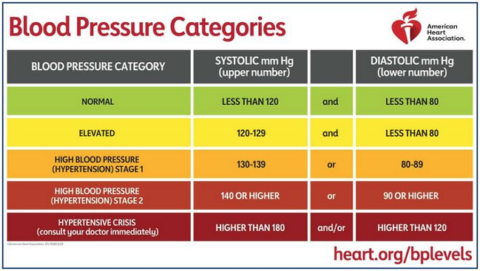By Lisa Thomas, Member Services
Club Greenwood changed medical insurance companies and the new company has a program that encourages you to get moving, tracked by various wrist devices. My husband purchased a watch for me that tracks so much, including blood pressure. I noticed my blood pressure fluctuating quite a bit; isn’t it supposed to stay fairly constant? That got me thinking…what is blood pressure really? So, I did a little research.
I am not a doctor, not in the medical field and most of the information I am providing here is easily “googleable”. I got a lot of the following information from the American Heart Association.
Your blood pressure is not static. It can be affected by your hydration level, your stress level or how much you are physically exerting yourself. It can change daily. So, what do the numbers mean?
The first number is your systolic blood pressure which tells you how much pressure your heart puts on your artery walls when it beats. The second number is your diastolic blood pressure which tells you how much pressure is being put on your artery walls between your heart beats. I really had no idea.
The American Heart Association divides the blood pressure range into five categories. If your systolic and diastolic numbers fall in different ranges, you should consider yourself in the elevated category.
Here are the categories at a glance:
If after taking your blood pressure you are NORMAL, keep it up and maybe check it monthly!
Elevated
Your heart is putting a little too much pressure on your arteries and you are at risk of developing high blood pressure or hypertension. Now is the time to eat better, start exercising and take the steps your doctor suggests to “nip it in the bud”.
Stage 1
You now added risk of a heart attack or stroke. Your doctor is key and may prescribe from as well as a healthier lifestyle to bring it down.
Stage 2
Heart attack and stroke risks intensify. Please consult your physician.
Hypertension Crisis
Seek medical attention immediately if you are testing at home. If you are experiencing symptoms such as chest pain, dizziness, shortness of breath, pain in the back, jaw, or arms; difficulty speaking, numbness or weakness, do not test yourself again and call 911.
Lastly, if you do not have a blood pressing testing machine at home. Please consider investing in one. They are inexpensive and worth the investment.
Now….I just need to figure out what SPO2 is and how it can be detected from my wrist?
 Lisa Thomas
Lisa Thomas
Lisa joined Club Greenwood in September of 1997. She is originally from California and is a graduate of the University of California at Davis with a degree in Electrical Engineering. Lisa met her husband, Art, skiing in California, and together they have raised four children: Arthur, Alyssa, Shelby, and Kendyl. She enjoys the outdoors, do-it-yourself renovations, and spending time with her grandchild, Owen.
Contact Lisa: [email protected]
303.586.7125 x284

